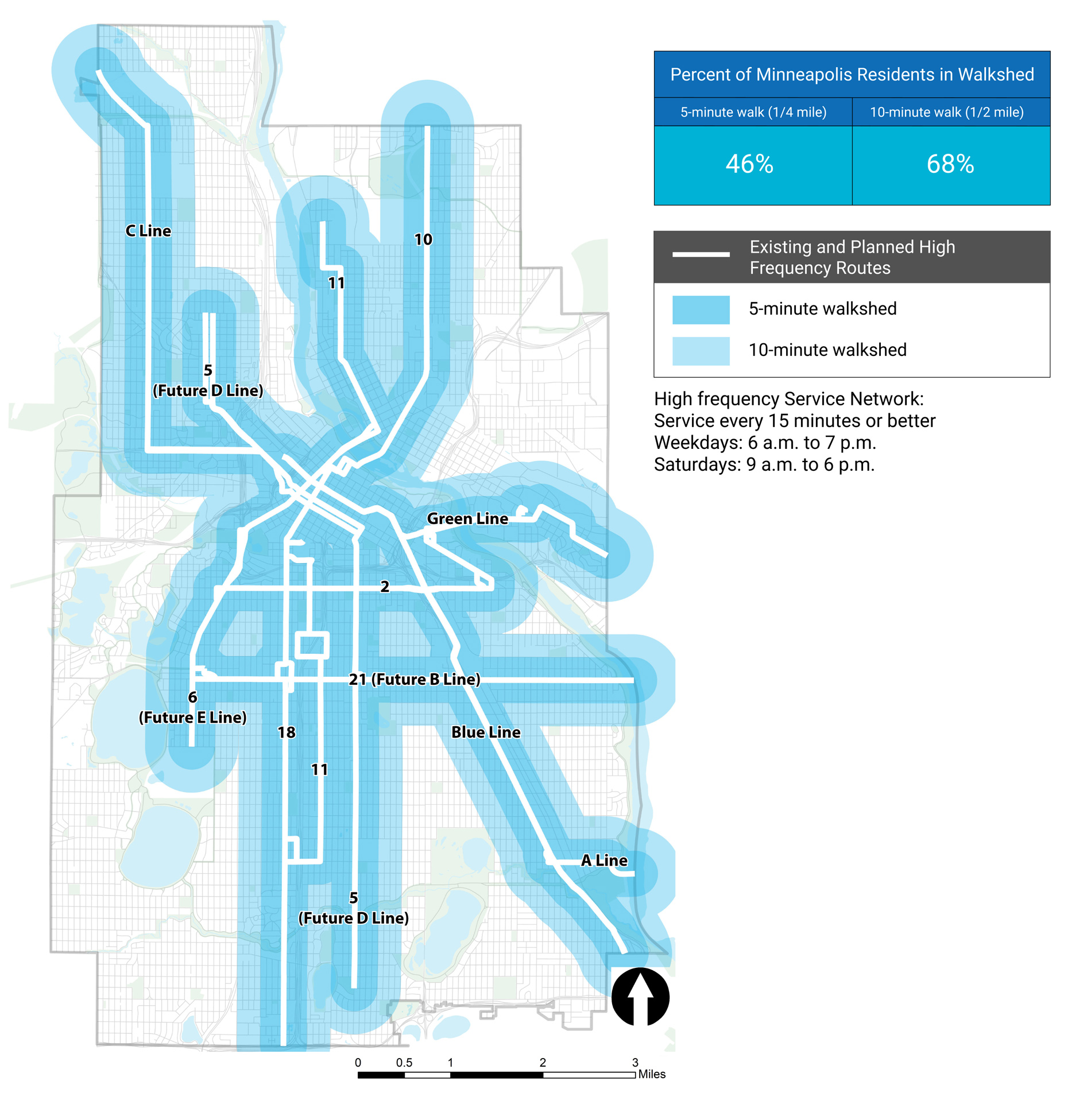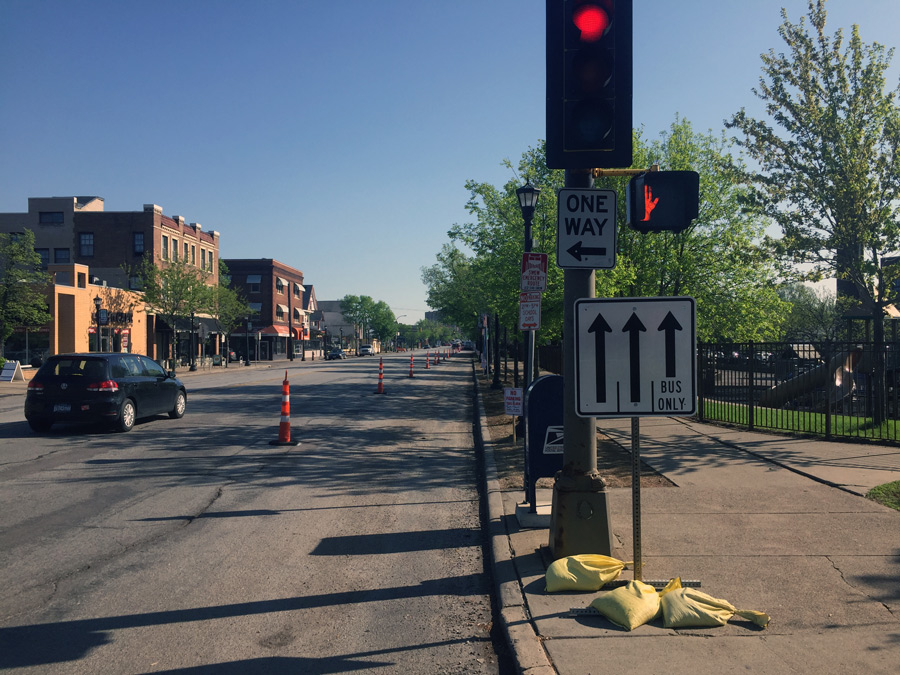Strategy 1 Increase transit coverage so that 75% of city residents are located within a quarter mile and 90% of residents are located within a half mile to high frequency transit corridors.
The actions within this strategy are divided into two categories:
Action we will DOActions we will SUPPORTAction we will do are followed by “DO” and are colored in dark gray, and actions we will support are followed by “SUPPORT” and are colored in light gray.
Learn more about how we get thereMinneapolis 2040 allows greater density of housing near existing and planned high frequency transit lines. The Transit Priority Projects map identifies corridors to improve frequency and reliability on existing routes and identifies where new crosstown services are needed.
High frequency transit corridors have service every 15 minutes during key weekday and Saturday hours. Currently, 47% of Minneapolis residents have a quarter mile access, or about a 5-minute walk, to high frequency transit. An additional 24% of people have access within a half mile, or about a 10-minute walk. The TAP sets a goal of 75% of city residents located within a quarter mile and 90% of residents located within a half mile walk to high frequency transit corridors. This strategy also looks to improve upon high frequency service from its current 15-minute interval to 10-minutes, in pursuit of even more improvement over time so that more people are able to rely on transit without the need to refer to a schedule for their everyday needs.
The current transit system undergoes minor service adjustments quarterly, with more major adjustments done through Metro Transit’s Service Improvement Plan and when major capital projects come online. The last full Service Improvement Plan was completed in 2015 with an update report in 2017, and Metro Transit’s Network Next will be looking at larger service adjustments systemwide in 2020. With many development and new population centers in Minneapolis, ensuring growth corridors are well served by transit is a focus of this strategy. Each of the strategies below will depend on upon the partnership with Metro Transit and should be coordinated with Network Next.
Actions to increase transit coverage and frequency.
Transit 1.1
Coordinate with Metro Transit’s Network Next plan to reflect the strategies and actions in this plan.
Supported goals:
Equity Prosperity Mobility Active Partnerships
Related actions:
Difficulty:
Medium
Timeframe:
2020-2023 (Years 0-3)
Status:
On-going
Transit 1.2
Establish enhanced neighborhood-based transit options, considering the use of new vehicle types, in growing neighborhoods to provide enhanced access and connections to housing, goods, services, employment and other destinations including existing high-frequency transit routes. Explore options along the downtown riverfront and North Loop first.
Supported goals:
Prosperity Mobility
Related actions:
Difficulty:
High
Timeframe:
2024-2027 (Years 4-7)
Transit 1.3
Expand the high frequency network.
Supported goals:
Equity Prosperity Mobility Active Partnerships
Related actions:
Difficulty:
High
Timeframe:
2020-2023 (Years 0-3)
Status:
On-going
Transit 1.4
Increase the high frequency network from 15 to 10 minutes or better.
Supported goals:
Equity Prosperity Mobility Active Partnerships
Related actions:
Difficulty:
High
Timeframe:
2028-2030 (Years 8-10)
Transit 1.5
Improve the quality and expand the high frequency network of local crosstown service, specifically from north to northeast Minneapolis and from south to southwest Minneapolis.
Supported goals:
Equity Prosperity Mobility Active Partnerships
Related actions:
Difficulty:
High
Timeframe:
2028-2030 (Years 8-10)
Transit 1.6
Expand coverage to new or growing markets and improve transit service to areas that are currently underserved based on potential demand from population or development increases. Focus initially on:
- Marshall St NE – between Broadway St NE and Lowry Ave NE
- Lyndale Ave N – between West Broadway and northern city boundary
- Lowry Ave – western city boundary to eastern city boundary
- Broadway – extend from Lyndale Ave N to the eastern city boundary
- Como Ave SE – between University Ave SE and eastern city boundary
- 38th St – Bryant Ave S to 42nd Ave S
- Xerxes Ave to 46th Street Station - travelling along 50th Street W, Bryant Ave S, 46th St E, Cedar Ave, 42nd St E, 28th Ave S, 46th St E
- Lyndale Ave S – Hennepin/Lyndale merge near Loring Park to southern city boundary
- Washington Ave – West Broadway to Cedar Ave continuing to 46th St
- 2nd St N – Hennepin Ave to Dowling Ave N
- Johnson St NE – Hennepin Ave to 37th Ave NE
- Xerxes Ave – 44th St W to 54th St W
- 28th Ave S – 38th St E to 58th St E
- 4th St SE and University Ave SE – Central Ave to 27th Ave SE
- Glenwood Ave/Penn Ave – N 10th St to Olson Memorial Highway
Supported goals:
Equity Prosperity Mobility Active Partnerships
Related actions:
Difficulty:
High
Timeframe:
2028-2030 (Years 8-10)
Transit 1.7
Work with Metro Transit and Minneapolis Public Schools to ensure the transit system offers safe, reliable and convenient transit routes and service for high school students.
Supported goals:
Climate Safety Equity Mobility Active Partnerships
Related actions:
Difficulty:
High
Timeframe:
2020-2023 (Years 0-3)
Transit 1.8
Support reverse commute service connecting Minneapolis residents to suburban employment centers.
Supported goals:
Climate Prosperity Mobility Active Partnerships
Related actions:
Difficulty:
Medium
Timeframe:
2020-2023 (Years 0-3)
Status:
On-going
Transit 1.9
Partner with Metro Transit to identify and secure bus layover locations, including restroom availability, that provide efficient access at the beginning of routes.
Supported goals:
Mobility Active Partnerships
Related actions:
Difficulty:
Medium
Timeframe:
2020-2023 (Years 0-3)
Status:
On-going
Transit 1.10
Explore partnerships and opportunities with private companies and other organizations to subsidize and implement neighborhood or employer circulators.
Supported goals:
Prosperity Mobility Active Partnerships
Related actions:
Difficulty:
Medium
Timeframe:
2028-2030 (Years 8-10)
See also actions:
- Technology 1.6
Research and integrate automated transit vehicles - Technology 6.7
Siting of electric charging stations


